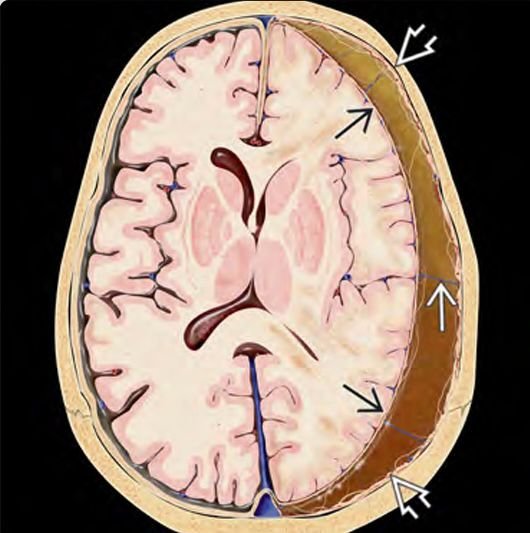Subdural Hematoma
Subdural Hematoma
Subdural Hematoma (SDH) in children is a serious form of traumatic brain injury where blood accumulates between the dura mater and the arachnoid membrane, the protective layers covering the brain. Pediatric SDH can be acute, subacute, or chronic, and often results from head trauma, including accidental falls, road traffic accidents, or non-accidental injuries such as child abuse. In Bangladesh, where pediatric neurosurgical care is still evolving and access in rural areas remains limited, timely diagnosis and expert treatment of subdural hematomas are essential to prevent long-term neurological disability or death. What Is Pediatric Subdural Hematoma? A Subdural Hematoma is caused by rupture of bridging veins between the brain surface and dura mater after a traumatic injury. Blood pools in the subdural space, leading to pressure on the brain tissue, which may cause brain swelling, reduced blood flow, and damage to brain cells. Children are particularly vulnerable due to their thin skull bones, larger head-to-body ratio, and softer brain tissue. SDH can also occur in neonates due to birth trauma or in infants due to shaken baby syndrome. Causes of Pediatric Subdural Hematoma in Bangladesh Falls from heights (rooftops, trees, stairs) Road traffic accidents (rickshaw, motorcycle, pedestrian injuries) Physical abuse or shaken baby syndrome Birth-related trauma Sports injuries during school or outdoor play Severe accidental blunt trauma Types of Pediatric Subdural Hematoma Acute SDH: Occurs within 72 hours of injury; often severe with rapid neurological decline. Subacute SDH: Develops between 3 and 14 days after injury; symptoms may be delayed. Chronic SDH: Develops over weeks to months; more common in infants and young children and may present subtly. Symptoms to Watch For in Children Persistent or worsening headache Vomiting or nausea Drowsiness or difficulty waking Seizures or convulsions Weakness or numbness on one side of the body Changes in behavior or irritability Poor feeding or lethargy in infants Bulging of the soft spot (fontanelle) in babies Unequal pupil size or abnormal eye movements Loss of consciousness or coma in severe cases Diagnosis of Pediatric Subdural Hematoma Early and accurate diagnosis is vital. Dr. Md. Nafaur Rahman utilizes: CT Scan of the Brain: The fastest and most effective imaging to detect subdural blood collections. MRI Brain: For detailed evaluation, especially in chronic or complex cases. Neurological Examination: Using Pediatric Glasgow Coma Scale (GCS) and neurological reflex testing. Intracranial Pressure (ICP) Monitoring: In severe cases to guide management. Treatment Approach by Dr. Md. Nafaur Rahman Medical Management Suitable for small hematomas with minimal symptoms Close hospital monitoring for neurological status Administration of anticonvulsants to prevent seizures Measures to reduce intracranial pressure like osmotic diuretics (mannitol) Supportive care including hydration and oxygen therapy Surgical Management Indicated for large hematomas causing significant brain compression or neurological deterioration Burr hole drainage or craniotomy to evacuate the hematoma Repair of any associated skull fractures or dura tears Postoperative intensive care monitoring and rehabilitation Dr. Nafaur emphasizes minimally invasive surgical techniques tailored for pediatric patients, ensuring quicker recovery and fewer complications. Prognosis and Long-Term Outcomes With prompt treatment, many children recover fully from subdural hematoma. However, delayed diagnosis or treatment can lead to: Permanent neurological deficits such as weakness or speech difficulties Cognitive impairment and learning disabilities Persistent seizures or epilepsy Behavioral and developmental challenges Increased risk of future head injuries In Bangladesh, raising awareness among parents and healthcare providers about early signs of head injury is crucial to improving outcomes. Why Pediatric Neurosurgical Expertise Matters in Bangladesh Pediatric head injuries like subdural hematomas require specialized neurosurgical care due to the delicate nature of the growing brain. Dr. Md. Nafaur Rahman provides: State-of-the-art neurosurgical facilities at NINS and Bangladesh Paediatric Neurocare Centre Experienced, child-focused neurosurgical care Emergency services for traumatic brain injury Comprehensive postoperative neurorehabilitation Community education on injury prevention and early care Contact Information for Expert Pediatric Neurosurgical Care 📌 Dr. Md. Nafaur Rahman Assistant Professor, Pediatric Neurosurgery, National Institute of Neurosciences & Hospital (NINS) Chief Consultant, Bangladesh Paediatric Neurocare Centre 📞 Appointments & Emergency Contact: 📱 +8801912988182 | +8801607033535 🌐 Website: www.neurosurgeonnafaur.com
YouTube Videos and Patient Reviews on Subdural Hematoma










